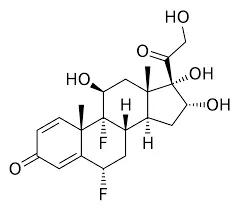Fluocinolone acetonide powder is a potent synthetic corticosteroid widely used in dermatology and ophthalmology for its anti-inflammatory, antipruritic, and vasoconstrictive properties. This medication works by reducing inflammation, itching, and redness associated with various skin conditions and eye disorders. Understanding its mechanism of action and applications is crucial for both healthcare professionals and patients to ensure its safe and effective use.
What conditions can Fluocinolone Acetonide Powder treat?
Fluocinolone acetonide powder is a versatile medication used to treat a wide range of conditions affecting the skin and eyes. Its potent anti-inflammatory properties make it particularly effective in managing chronic and acute inflammatory disorders.
In dermatology, fluocinolone acetonide is commonly prescribed for various skin conditions, including:
- Eczema (atopic dermatitis)
- Psoriasis
- Contact dermatitis
- Seborrheic dermatitis
- Lichen planus
- Discoid lupus erythematosus

The medication helps alleviate symptoms such as itching, redness, swelling, and flaking associated with these conditions. Its ability to reduce inflammation and suppress the immune response in the affected areas makes it an effective treatment option for managing flare-ups and maintaining remission in chronic skin disorders.
In ophthalmology, fluocinolone acetonide is used to treat various eye conditions, including:
- Uveitis (inflammation of the uvea)
- Diabetic macular edema
- Retinal vein occlusion
For eye conditions, fluocinolone acetonide is often administered as an intravitreal implant, providing sustained release of the medication over an extended period. This approach is particularly beneficial for chronic conditions that require long-term management.
The versatility of fluocinolone acetonide powder in treating various inflammatory conditions stems from its ability to modulate the immune response and reduce inflammation at the cellular level. By addressing the underlying inflammatory processes, it effectively manages symptoms and improves the quality of life for patients suffering from these conditions.
How long does it take for Fluocinolone Acetonide Powder to work?
The onset of action and duration of effectiveness for fluocinolone acetonide powder can vary depending on several factors, including the condition being treated, the severity of symptoms, and the individual patient's response to the medication. Understanding the timeline for improvement can help patients and healthcare providers set realistic expectations and adjust treatment plans as needed.

For skin conditions:
- Initial improvement: Many patients experience some relief from symptoms such as itching and redness within 24 to 48 hours of starting treatment.
- Significant improvement: More substantial improvements in skin appearance and symptoms are typically observed within 3 to 7 days of consistent use.
- Full effect: For some chronic conditions, it may take 2 to 4 weeks of regular application to achieve maximum therapeutic benefit.
It's important to note that while some patients may experience rapid improvement, others may require more time to see significant results. Consistency in application and adherence to the prescribed treatment regimen are crucial for achieving optimal outcomes.
For eye conditions treated with intravitreal implants:
- Initial effects: Patients may begin to notice improvements in vision and reduction of inflammation within the first few weeks following implantation.
- Sustained effect: The implant is designed to release the medication gradually over an extended period, typically 24 to 36 months, providing long-term management of chronic eye conditions.
The extended-release nature of intravitreal implants offers a significant advantage in managing chronic eye conditions, reducing the need for frequent interventions and providing sustained therapeutic effects.
Factors influencing the speed and extent of response to fluocinolone acetonide powder include:
- Severity of the condition
- Duration of symptoms prior to treatment
- Concurrent use of other medications
- Patient compliance with the treatment regimen
- Individual variations in metabolism and response to corticosteroids
Healthcare providers may adjust the dosage or frequency of application based on the patient's response to optimize treatment outcomes. Regular follow-up appointments are essential to monitor progress and make any necessary modifications to the treatment plan.
Is Fluocinolone Acetonide Powder safe for long-term use?
The safety of fluocinolone acetonide powder for long-term use is a critical consideration for both healthcare providers and patients, particularly when managing chronic conditions that may require extended treatment periods. While fluocinolone acetonide is generally considered safe and effective when used as directed, long-term use necessitates careful monitoring and assessment of potential risks and benefits.
Factors to consider for long-term safety:
- Potency: Fluocinolone acetonide is a high-potency corticosteroid, which makes it effective for treating various conditions but also increases the risk of side effects with prolonged use.
- Application site: The safety profile may differ depending on whether the medication is used on the skin or administered as an intravitreal implant for eye conditions.
- Individual patient factors: Age, overall health status, and concurrent medications can influence the long-term safety and tolerability of fluocinolone acetonide.
For topical use in skin conditions:
- Short-term use (up to 2-4 weeks) is generally considered safe for most patients when used as directed.
- Long-term use should be approached with caution and under close medical supervision.
- Intermittent or pulsed therapy may be recommended for chronic conditions to minimize the risk of adverse effects associated with prolonged use.
Potential concerns with long-term topical use include:
- Skin thinning (atrophy)
- Increased susceptibility to skin infections
- Changes in skin pigmentation
- Systemic absorption, particularly when used on large areas of skin or under occlusion
For intravitreal implants used in eye conditions:
- Long-term safety data from clinical trials support the use of fluocinolone acetonide intravitreal implants for up to 36 months in treating certain chronic eye conditions.
- Regular monitoring of intraocular pressure and cataract formation is essential during long-term treatment.
Strategies to enhance long-term safety:
- Regular follow-up appointments to assess treatment efficacy and monitor for potential side effects
- Use of the lowest effective dose for the shortest duration necessary to control symptoms
- Gradual tapering of the medication when discontinuing long-term use to prevent withdrawal symptoms
- Patient education on proper application techniques and potential signs of adverse effects to report
While fluocinolone acetonide powder can be safe for long-term use in many cases, individualized treatment plans and close medical supervision are essential to balance the therapeutic benefits with potential risks. Healthcare providers should regularly reassess the need for continued treatment and explore alternative therapies or combination approaches to minimize long-term corticosteroid exposure when possible.
If you are also interested in this product and want to know more product details, or want to know about other related products, please feel free to contact sasha_slsbio@aliyun.com.
References
- National Center for Biotechnology Information. PubChem Compound Summary for CID 9572, Fluocinolone acetonide.
- DailyMed - FLUOCINOLONE ACETONIDE- fluocinolone acetonide cream.
- Campochiaro, P. A., et al. (2012). Sustained delivery fluocinolone acetonide vitreous inserts provide benefit for at least 3 years in patients with diabetic macular edema. Ophthalmology, 119(10), 2125-2132.
- Ference, J. D., & Last, A. R. (2009). Choosing topical corticosteroids. American Family Physician, 79(2), 135-140.
- Fung, A. T., et al. (2020). Local delivery of corticosteroids in clinical ophthalmology: A review. Clinical & Experimental Ophthalmology, 48(3), 366-401.
- Gabros, S., & Zito, P. M. (2021). Topical Corticosteroids. In StatPearls. StatPearls Publishing.
- Hengge, U. R., et al. (2006). Adverse effects of topical glucocorticosteroids. Journal of the American Academy of Dermatology, 54(1), 1-15.
- Jaffe, G. J., et al. (2019). Fluocinolone acetonide intravitreal implant for diabetic macular edema: a 3-year multicenter, randomized, controlled clinical trial. Ophthalmology, 126(8), 1121-1133.
- Mehta, A. B., et al. (2016). Fluocinolone acetonide: A review of its use in the management of diabetic macular oedema. Drugs, 76(13), 1285-1296.
- Coondoo, A., et al. (2011). Side-effects of topical steroids: A long overdue revisit. Indian Dermatology Online Journal, 2(1), 33-41.

